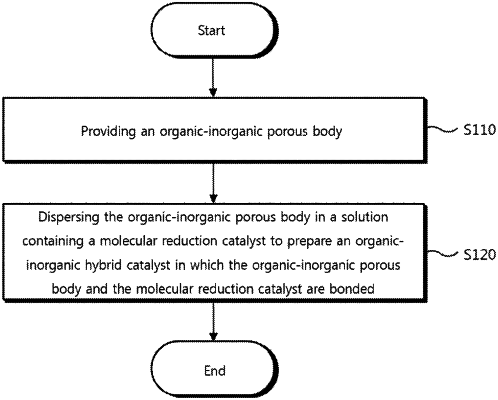| CPC B01J 35/0006 (2013.01) [B01J 21/066 (2013.01); B01J 31/183 (2013.01); B01J 31/1815 (2013.01); B01J 35/004 (2013.01); B01J 35/10 (2013.01); B01J 37/0215 (2013.01); C01B 32/40 (2017.08); B01J 2531/004 (2013.01); B01J 2531/26 (2013.01); B01J 2531/74 (2013.01); C23C 16/45553 (2013.01)] | 7 Claims |

|
1. A method for preparing a composite catalyst for carbon dioxide reduction, the method comprising:
providing an organic-inorganic porous body;
dispersing the organic-inorganic porous body in a solution containing a molecular reduction catalyst having a rhenium (Re) complex to prepare a composite catalyst in which the organic-inorganic porous body and the molecular reduction catalyst are bonded,
wherein the organic-inorganic porous body includes a metal oxide cluster containing zirconium oxide (Zr6O8) and a light harvesting organic material with zinc-porphyrin (ZnP) as a linker between the metal oxide clusters, and the linker absorbs visible light to form an exciton, and moves the exciton through energy transfer between the linkers to transfer an electron of the exciton to the molecular reduction catalyst, and
coating a surface of the organic-inorganic porous body with a ceramic shell containing titanium oxide (TiO2) after providing the organic-inorganic porous body, wherein the electron of the exciton formed by the linker is transferred to the molecular reduction catalyst through the metal oxide cluster coated with the ceramic shell.
|